|
In last week's post (here) I gave some tips on playing fiddle tunes in the low octave on banjo. For that post I purposefully picked a section of a tune (the A part of "Barlow Knife") for which the low octave falls entirely within the banjo's range. However, the banjo doesn't have the range to play full low octave parts of most tunes in standard tunings; this week I'll give some tips for playing the low octave on tunes like this.
My tune of choice for this exercise is "Soldier's Joy," which is probably one of the first tunes most clawhammer players learn. While many people groan when "Soldier's Joy" is called at a jam, I still greet this one with excitement because I just love playing my low octave B part; its this part of the tune that I'll focus on today. Lets get started by hearing a simple fiddle (OK...mando) version of the B part:
Example 1 - Me playing the B part of "Soldier's Joy" on my still-new-to-me Bacon mando (here).
I'm guessing that sounds pretty familiar to most anyone reading this. You may notice that many fiddlers take a few more "melodic liberties" with their versions; I've purposefully kept my version here a bit closer to the streamlined consensus version I hear out of clawhammer players. Speaking of which, let's check out a banjo tab for the standard "high octave" part:
Figure 1 - A standard "high octave" B part for "Soldier's Joy" on clawhammer banjo.
The tab in Figure 1, along with every other tab below, is meant to be played in double D tuning (aDADE), which is the tuning clawhammer players tend to use for most D tunes. I also suggest using the following left hand position (click here if you don't know what I'm talking about) for playing Figure 1, and every other tab below as well:
Hand Position for Figures 1-5: 2nd fret - index finger 3rd fret - middle finger 4th fret - ring finger 5th fret - pinky finger Finally, to avoid harmonic clutter, I've replaced brushes with ghost notes (if you're not familiar with ghost notes, I've got an explanation about halfway down this post). So let's hear what Figure 1 sounds like (once again, played alongside a mando for context):
Example 2 - Me playing the tab shown in Figure 1 on my Buckeye in aDADE tuning.
(Mando from Example 1 included as well)
Not too bad...but let's make things a bit more interesting by trying to find a low banjo part to contrast the mando. As I hinted at above, if you stick to double D tuning and try to find the melody in the low octave you'll end up out of range for a few notes. Here's a "low octave" tab of the B part for "Soldier's Joy;" you'll notice that four notes are marked "too low" and omitted:
Figure 2 - A "low octave" B part for "Soldier's Joy" on clawhammer banjo with 4 notes that fall outside the range of the banjo in aDADE tuning omitted (these notes are marked "too low").
So, the good news is, we can play most of the B part to "Soldier's Joy" in the low octave. But how do we deal with the notes that we can't play? I've got 3 approaches that I'll outline below
Approach 1 - jump to the high octave That's right, when I run out of notes in the low octave, I frequently just jump up to get them in the high octave. When you're the only solo instrument, this approach can sound a little strange, but when you're playing with a fiddler it really doesn't stick out that much. While you could jump to the high octave for single out of range notes, I think the "aesthetics" of this work a little better if you jump up an octave for a whole melodic phrase instead. If you look back at Figure 2, you'll notice that I've drawn dotted lines around 2 phrases that go out of range (note - apparently I favored roman numerals when labelling phrases...not sure where that came from). In the following tab, I'll replace phrases I and II with their "high octave" counterparts from Figure 1.
Figure 3 - A "low octave" B part for "Soldier's Joy" on clawhammer banjo with two phrases replaced with "high octave" playing.
Here's a sound clip of Figure 3 played alongside the mando:
Example 3 - Me playing the tab shown in Figure 3 on my Buckeye in aDADE tuning.
(Mando from Example 1 included as well)
Approach 2 - "Fill in the blanks" with chords
Probably no need to over-explain this one : ) In the following tab, I replaced phrases I and II (as labelled in Figure 2) with simple "bum ditty's." In this case, both phrases happened to occur over A chords:
Figure 4 - A "low octave" B part for "Soldier's Joy" on clawhammer banjo with two phrases replaced with chords. Note - these chords force you to break left hand position; I finger them using my index finger on the 2nd fret of the 4th string and my middle finger on the 2nd fret of the 2nd string.
Let's hear this one too:
Example 4 - Me playing the tab shown in Figure 4 on my Buckeye in aDADE tuning.
(Mando from Example 1 included as well)
Approach 3 - Replace the out of range phrase with something else in the low octave
This one's a bit of a grab bag. The idea is to play a melodic phrase in the low octave that rhythmically-mirrors what's going on in the fiddle's melody without clashing. As an example: if you look at the "out of range" phrases in Figure 2 that we're trying to replace, you'll notice that phrase I is five uninterrupted notes in succession (i.e. no rests in between notes), while phrase II is three uninterrupted notes in succession. In the following tab, I've replaced these phrases with five-note and three-note phrases in the low octave that differ from the fiddle's melody, but don't sound too bad alongside it:
Figure 5 - A "low octave" B part for "Soldier's Joy" on clawhammer banjo with two phrases replaced with....something else in the low octave : )
Its probably a stretch to call these "harmonies" or "counter melodies"....I just picked them out by ear and they kind of work with what's going on. In fact, I'm not sure I'm too happy with what I chose for phrase I (could clash with chords?), but you get the idea : )
For good measure, lets hear this one too:
Example 5 - Me playing the tab shown in Figure 5 on my Buckeye in aDADE tuning.
(Mando from Example 1 included as well)
Anyways, I don't have a real favorite approach for "filling in the blanks" of an out of range low octave melody; really, I just kind of mix and match these approaches throughout a tune for variety. If you add in potential "high octave" variants for the B part, one need never be bored with "Soldier's Joy" again!
Hope this post inspires you to find "low octave" variants of your favorite fiddle tune....even if you run out of notes : )
1 Comment
|
-----
|
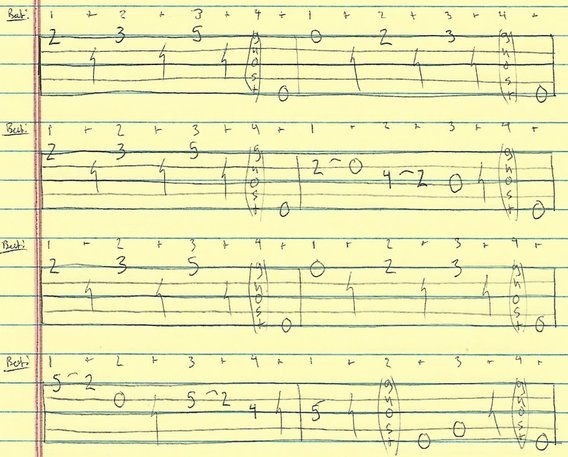
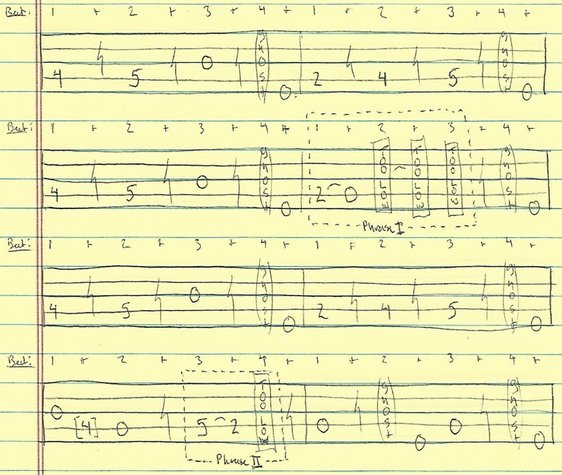
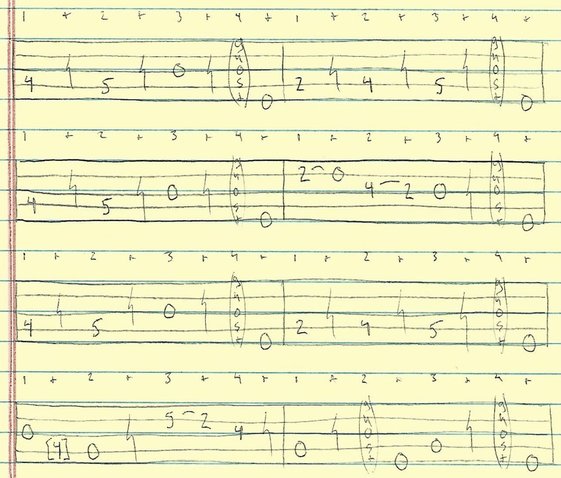
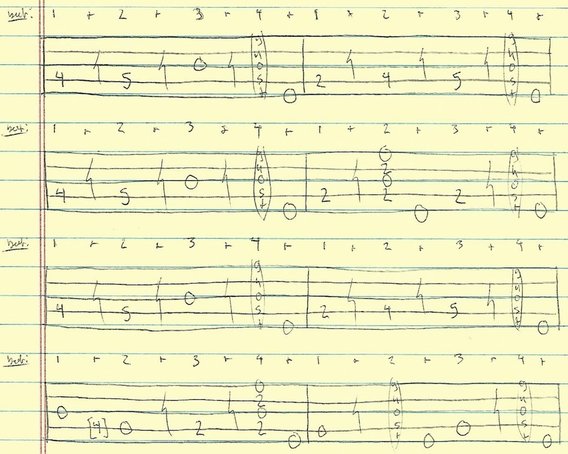
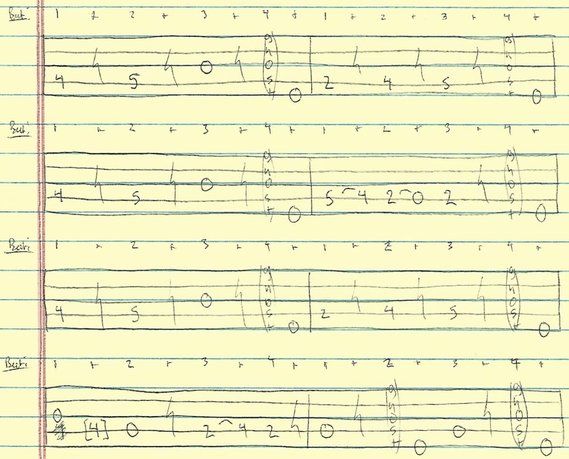
 RSS Feed
RSS Feed